Ijraset Journal For Research in Applied Science and Engineering Technology
- Home / Ijraset
- On This Page
- Abstract
- Introduction
- Conclusion
- References
- Copyright
Assessment of Rooftop Rainwater Harvesting Potential: A Case Study for Nagaland
Authors: Y. S. Tsopoe, L. Sangtam, S. Umadevi, K. Chophy, K. N. Chewang, X. N. Chophi, H. P. Konyak, C. Lairenjam
DOI Link: https://doi.org/10.22214/ijraset.2024.61317
Certificate: View Certificate
Abstract
Water scarcity has become a serious global threat due to hazardous population growth frequent droughts and changing climate pattern (Carolina B. Mendez et. al). Water is scarce natural resource, even though 71% of land is covered by water out of total water on the earth near about 25% are fresh which is being utilized for various purposes viz. domestic, irrigation and industrial are common. Nowadays the need of commercial water is magnifying tremendously in a developing country like India which has long tradition of rural culture. Here in this study, an attempt was made to estimate the potential of rooftop rainwater harvesting in the state of Nagaland, India. The results showed that the total domestic water demand of Nagaland was estimated at 62,012,868,550 liters and domestic supply potential only from rooftop rainwater harvesting was estimated to fulfill about 64.70% of total water demand and the shortage which is about 35.3% can be through state governments water supply scheme, from the private sector and also other sources like pond, river, spring water, etc.
Introduction
I. INTRODUCTION
Rainwater harvesting has been practiced for over 4,000 years throughout the world, traditionally in arid and semi-arid areas, and has provided drinking water, domestic water and water for livestock and small irrigation. This Rooftop rainwater harvesting is a simple technique of catching and holding rainwater where it falls. Either, we can store it in tanks or we can use it to recharge groundwater depending upon the situation. Rainwater infiltration is another aspect of rainwater harvesting playing an important role in storm water management and in the replenishment of the groundwater levels. The term of rain water harvesting is being frequently used these days, however, the concept of water harvesting is not new for India, and this technique had been evolved and developed centuries ago.The practice of collecting rainwater from rainfall events can be classified into two broad categories: land-based and roof-based. Land-based rainwater harvesting occurs when runoff from land surfaces is collected in furrow dikes, ponds, tanks and reservoirs. Roof-based rainwater harvesting refers to collecting rainwater runoff from roof surfaces which usually provides a much cleaner source of water that can be also used for drinking. According to studies by Central Ground Water Board, the ground water in many parts of India would dry up or decrease immensely by the year 2025 and that’s why an effective and efficient method is required to cope up with the decreasing ground water levels. One such method is the rooftop rainwater harvesting practice. Harvesting water from rooftop needs special attention as it improves both quality and quantity of ground water as suggested by a case study in Jamia Milia Islamia at New Delhi. In India, the per capita availability of water is 1545 cubic meters as per the census of 2011 which was 1816 cubic meters in 2001. It is reducing progressively from 5000 cubic meters in 1950. Rainwater is a natural, reliable and least polluted source of water which could be harnessed through simple and scientific techniques of rainwater harvesting. Keeping the above mentioned facts in view, this present study has been taken up with the following objectives:
- To determine and compare the potential of the rooftop rainwater harvesting and water demand in Dimapur District.
- To estimate Water demand of various district of Nagaland.
- Comparative study of the water demand and potential rooftop water harvesting.
II. MATERIALS AND METHODOLOGY
A. Study Area
Nagaland is a state of India located in the far north-eastern part of the country. It borders the states of Assam to the west, Arunachal Pradesh to the north, and Manipur to the south. Nagaland lies between 93°20'E and 95°15'E longitude and between 25°6'N and 27°4'N latitude. The state is administratively divided into 11 districts namely: Kohima, Phek, Wokha, Zunheboto, Mokokchung, Tuensang, Longleng, Peren, Kiphire, Dimapur and Mon as per the 2011 census record. The location map of the stuy area is shown in Fig 1.
B. Climatic and topographic details
The physiographic conditions of the state are characterized by elevated ridges and intermountain valleys. The topography of the state is highly undulating with elevation varying from 160m to 3841 m above mean sea level. Nagaland has a monsoonal (wet-dry) climate. Annual rainfall averages between 70 and 100 inches (1,800 and 2,500 mm) and is concentrated in the months of the southwest monsoon (May to September). Average temperatures decrease with greater elevation; in the summer temperatures range from the low 70s F (about 21–23 °C) to the low 100s F (about 38–40 °C), while in the winter they rarely drop below 40 F (4ºC), though frost is common at higher elevations.
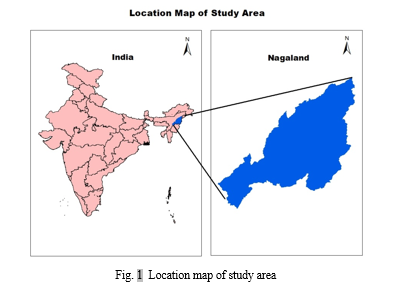
C. Agricultural Practices
Jhum cultivation is the traditional farming system in the Nagaland state. Maize, Millets and vegetables are grown on hills slopes and rice is cultivated in hilly terraces. The total area under traditional cultivation includes Jhum paddy cultivation, terrace paddy cultivation, maize, oil seed and pulses cultivation. The area under paddy cultivation is 0.174Mha. The area under commercial crops cultivation is about 0.043Mha and cultivation of other cereals is about 0.0061ha. The majority of the income can be attributed to agriculture; consequently, the importance of the timing and amount of rainfall that occurs in Nagaland cannot be overstated.
D. Rainfall Data
The rainfall data of Nagaland were taken from the Water Resource Department, Nagaland. The data was used to calculate the average annual rainfall of all the different districts as well as the whole state.
E. Population Data
Population data and household data were collected from Census Record of 2011. Houses categorized by their used condition in Nagaland (district wise) according to the census record of 2011was also collected. Household data were used for calculation of runoff.
F. Potential of Rooftop Rainwater Harvesting
Potential of roof rainwater harvesting refers to the capacity of an individual roof to harness the waterfalls on that roof in a particular year covering all rainy days. The annual yield of water which is probably measured in unit of litters is the product of roof type and annual average rainfall of an area. Rain water yield varies with the size and texture of the catchment area. A smoother, cleaner and impervious roofing material contributes to better water quality and greater quantity (R.W.H.C.M., 2002). Potential of roof rainwater harvesting in a study area has evaluated by using the following formula of given by Gould and Nissen Equation:
P=R×A×Cr
Where,
P = Potential of roof rainwater harvesting (In cu. m)
R = Average annual rain fall in m.
A = Roof area in Sq. m.
Cr = Coefficient of Runoff.
G. Estimation of Runoff
Estimation of rooftop runoff required rainfall of the given area, rooftop area and runoff co-efficient. By multiplying these three factors the rooftop runoff volume was estimated. Three different rooftops namely good, lively, and dilapidated were considered for the runoff estimation and runoff co-efficient for each rooftop were taken as 0.8, 0.7 and 0.6 respectively. Rooftop areas are varying from one house to another, so for estimation of runoff, the optimum rooftop size in Nagaland was considered as 80 sq m.
H. Water Demand
Daily water demand was calculated using the population data and daily water consumption per person in the state. IS 1172:1993 was referred for daily water requirement per person in urban areas as well as in rural areas. The daily water requirement per person per day in rural areas was 70 liters per head per day and for urban areas, the daily water requirement per person per day was taken as 125 liters per head per day.
III. RESULTS AND DISCUSSION
A. Rainfall Data
The rainfall data for the year 2020 of Nagaland was collected from the Water Resource Department, Nagaland. The data was used to calculate average annual rainfall of all the different districts as well as the whole state as shown in Fig 2 and Table I.
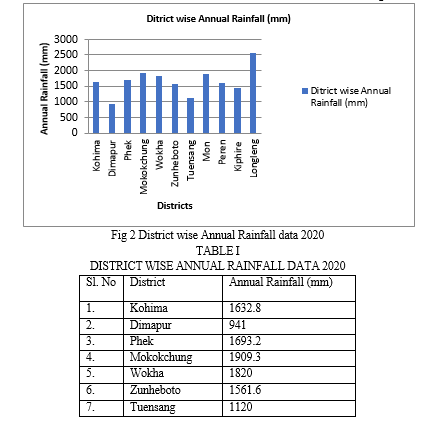
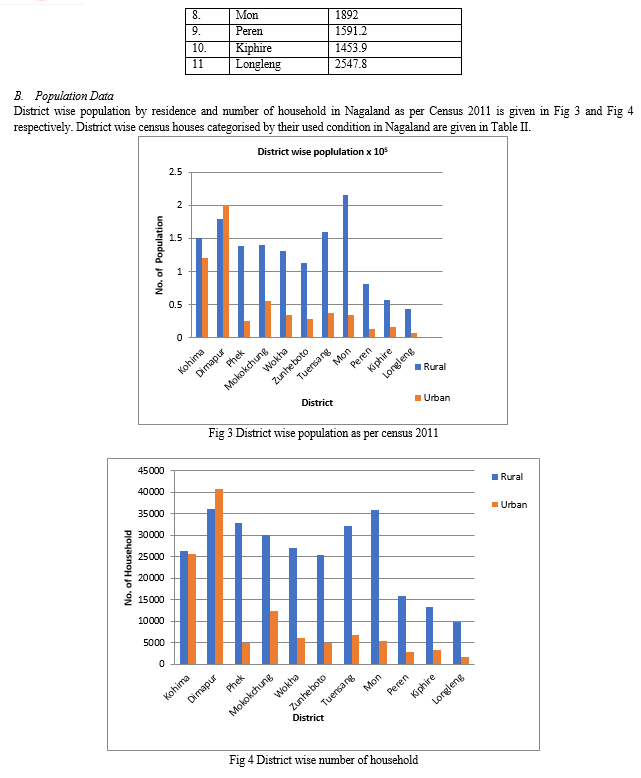
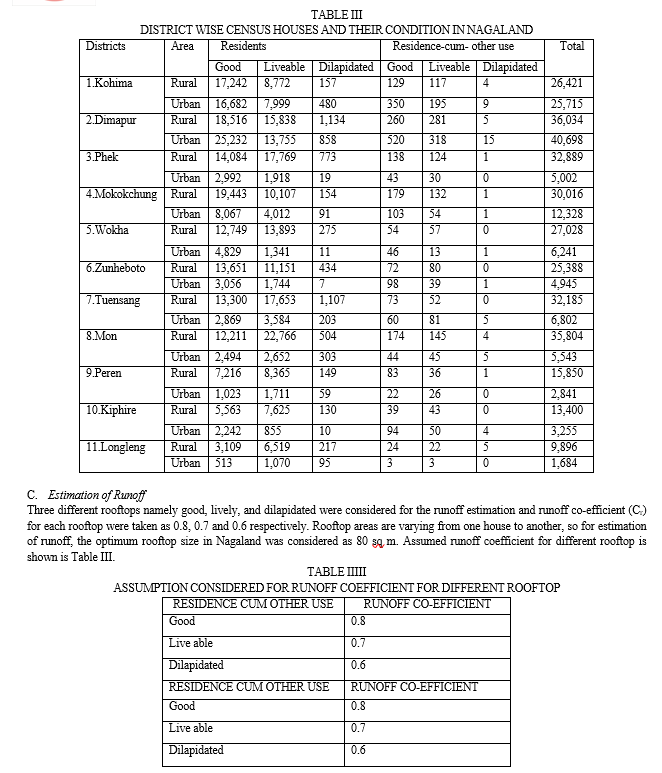
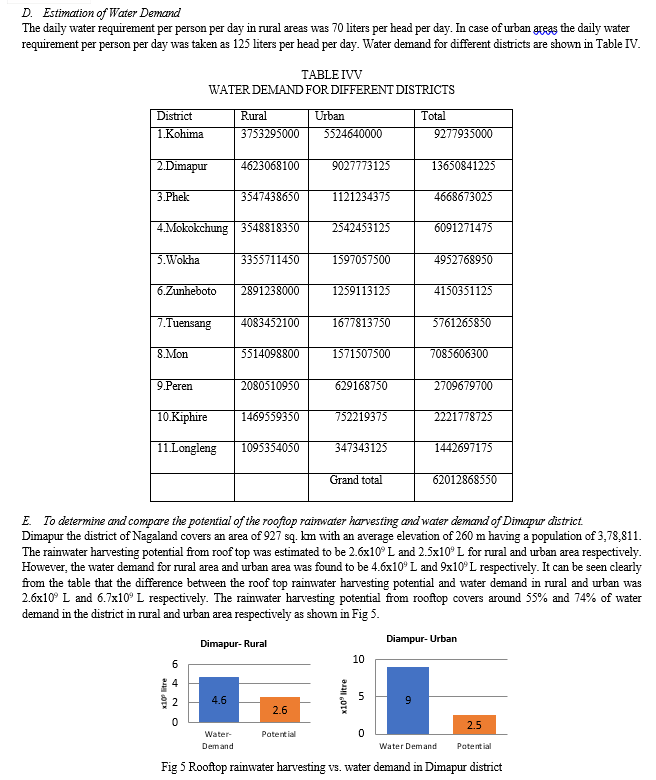

IV. ACKNOWLEDGMENT
At the onset, we give all glory and honor to God for His blessings and love for enabling us to complete our project successfully. We would like to give a very special thanks to our project guide, Dr Chitrasen Liarenjam, Assistant Professor, Agricultural Engineering and Technology, Nagaland University, for his guidance and support and for imparting his knowledge throughout the project session. We would also like to thank the Directorate of Statistics and Economics, Nagaland for providing out team with the information and data required in this study. We take this time to thank our parents, friends, AET department faculty, and well-wishers for their love and inspiration, making our educational journey a memorable one.
Conclusion
Rainwater harvesting appears to be one of the most promising alternatives for the escalating demand of fresh water. Hydrological analysis is the basic criteria for the design of rainwater harvesting structure and to find out total water demand of any study area. In this study only the rooftop rainwater harvesting was considered as one of the optional methods for supply of domestic water requirement .Other major water demand sectors like irrigation, animal husbandry, industries, hydropower, fisheries, etc in Nagaland can be further considered for future studies. There are many water harvesting structures available for storage of runoff from rainwater like lake, pond, dam, tank, etc. which can also be considered for future studies on the rainfall runoff relation. From above result we conclude that the rooftop rainwater harvested is 64.71% of the total water demand which is useful during dry season, by storing it during the monsoon. Therefore water stored in other sources will not be in use when rainwater is available. By providing this system, use of rain water during the dry season is 100%. Installation cost of this system for study area is very less and provision for conveyance system and collection chamber in every house will increase water for dry season and improve the wellbeing of the society efficiently. Thus it is concluded that implementation of rainwater harvesting system by the Department of Water Resources, Nagaland would result in the form of the best approach to deal with present scenario of water scarcity and storing a huge quantity of water in a year.
References
[1] A. Jebamalar, & G. Ravikumar, A comparative analysis of hydrologic responses to rainwater harvesting: a case study. Indian Journal of Science and Technology, 2011,4 (1): 34—39. [2] H. Weerasinghe, U.A. Schneider, and A. Low, Water harvest and storage locaton assessment model using GIS and remote sensing. Hydrol. Earth Syst. Sci. Discuss,2011, 8: 3353–3381. [3] J. Biswas, S. Sahoo, S. Debsarkar, and M. Pal, Assessment of adoption potential of rooftop rainwater harvesting to combat water scarcity: A case study.Arabian Journal of Geosciences, 2021, 14(1636). [4] K.P. Kumar, & B.S.Muruganandam, Assessment of rainwater harvesting potential for a part of Chandighar. International Journal of Civil Engineering and Technology (IJCIET), 2017, 8 (9): 91—98. [5] O.A. Chowdhury, Z. Hossain, & S.J. Begum. Design of rooftop rainwater harvesting: a case study on halishahar chittagong residential area. International Conference on Sustainable Development, 2015, 21—22. [6] S. Jain, P. Thakur, P. Singh, & M. Srivastava, Design of rooftop rainwater harvesting tank for katpadi region, Tamil Nadu. SSRG International Journal of Civil Engineering (SSRG-IJCE), 2015, 2 (7): 6—8. [7] S. R. Ali, (2015), Rainwater harvesting for recharging groundwater-a case study for nursing college T.M.U. Moradabad. International Journal of Advance Research In Science and Engineering, IJARSE, 2015, vol. 4(01): 238-245. [8] S.K. Tripathi, B. Sharma, and P. Raha, Evaluation of site suitablity and storage capacity of constructed rainwater harvesting structure in Vindhyan Region, India. Indian Journal of Ecology, 2016, 43 (1): 39—42. [9] S.P. Sangeetha, P.A. Raj, A. Sebastin, V.S. Nair, and H. Samad, Application of rooftop rainwater harvesting system in North East India. International Journal of Innovative Technology and Exploring Engineering (IJITEE),2020, 9 (3): 3575—3577. [10] T. Malambo, & Q.H. Huang, Roooftop rainwater harvesting as an alternative domestic water resource in Zambia. Journal of Geoscience and Environment Protection,2016, 4: 41—57. [11] Z. Hari, Estimation of rootop raiwater harvesting potential using applications of and GIS. International Journal of Innovative Technology and Exploring Engineering, 2019, 8 (9): 1122—1127 .
Copyright
Copyright © 2024 Y. S. Tsopoe, L. Sangtam, S. Umadevi, K. Chophy, K. N. Chewang, X. N. Chophi, H. P. Konyak, C. Lairenjam. This is an open access article distributed under the Creative Commons Attribution License, which permits unrestricted use, distribution, and reproduction in any medium, provided the original work is properly cited.

Download Paper
Paper Id : IJRASET61317
Publish Date : 2024-04-30
ISSN : 2321-9653
Publisher Name : IJRASET
DOI Link : Click Here
 Submit Paper Online
Submit Paper Online

